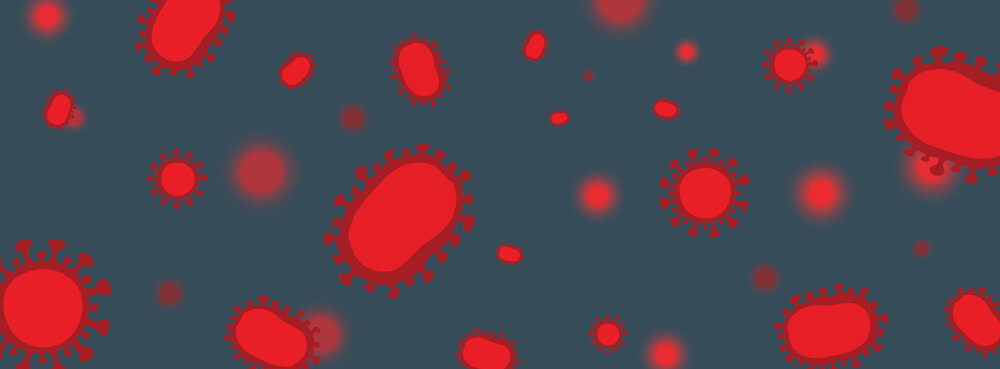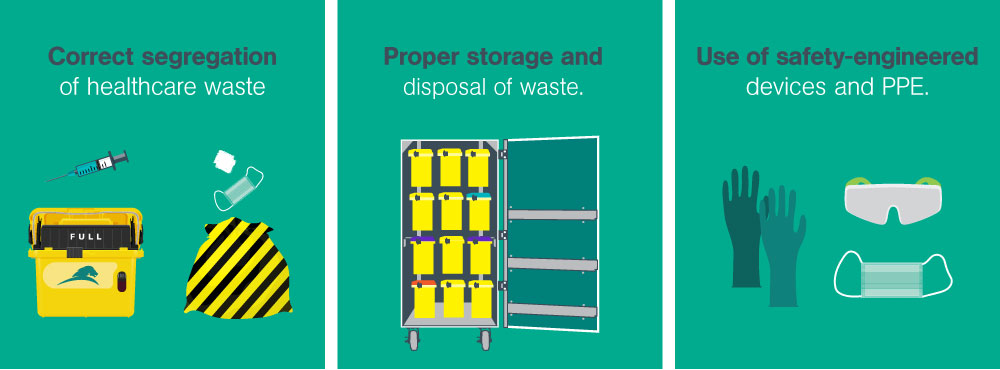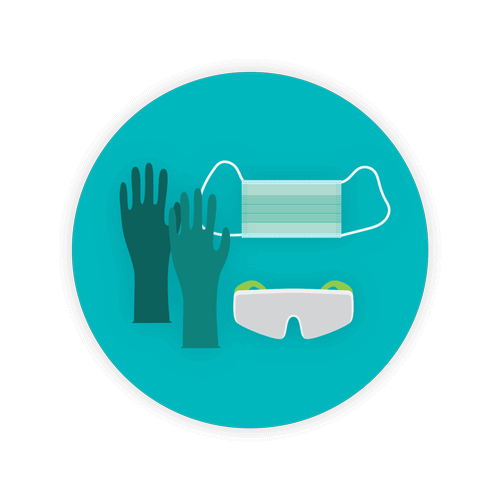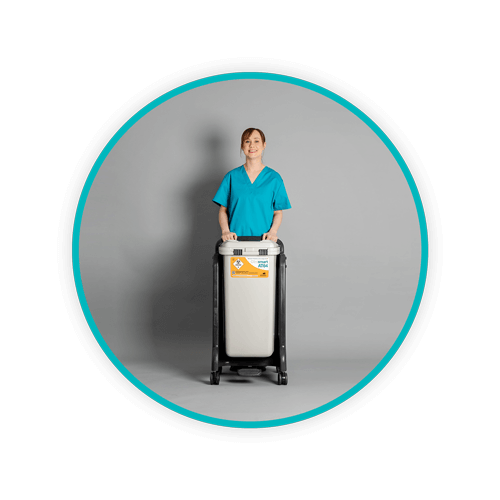Preventing Pathogen Spread in Clinical Waste Disposal

Invisible to the human eye and potentially deadly, pathogens are amongst the scariest things you’ll find in the healthcare environment. The question is, how do you prevent what you can’t see?
Proper disposal of clinical waste is paramount in healthcare settings, as it prevents the spread of pathogens and maintains a safe environment. This blog explores essential actions to prevent the spread of pathogens when disposing of clinical waste, highlighting the importance of safe waste disposal practices and providing guidance on handling infected waste and soiled linen.
By implementing these measures, healthcare facilities can significantly reduce infection transmission risks and ensure compliance with regulatory standards.
TOPICS WE WILL COVER:
1 / Understanding Clinical Waste and Its Risks
2 / Essential Actions to Prevent Pathogen Spread
3 / Innovative Approaches to Clinical Waste Management
4 / Ensure Compliance with Safe Ways of Disposing Waste
6 / Sharpsmart: Ensure Correct Waste Disposal for Your Facility
7 / Get In Touch with the Experts in Clinical Waste
Understanding Clinical Waste and Its Risks
It refers to a specific type of waste produced in healthcare settings that poses a risk of infection, disease, or harm to anyone who comes into contact with it. This includes waste from hospitals, health clinics, dental practices, and research labs. It’s important to understand that while not all waste from healthcare environments qualifies as clinical waste, all of it is classified as healthcare waste.
Examples of clinical waste include sharps waste, anatomical waste, pharmaceutical waste, infectious waste, contaminated PPE, and microbial waste, among others. The risks associated with improper clinical waste disposal are significant, including:
- Cross-contamination between patients, staff and other waste types
- Environmental contamination
- Needlestick injuries and potential bloodborne pathogen exposure
According to the World Health Organisation (WHO), around 15% of healthcare waste contains potentially harmful microorganisms that can infect hospital patients, healthcare workers, and the general public.
Essential Actions to Prevent Pathogen Spread
Here are essential actions to prevent the spread of pathogens when disposing of clinical waste:

Wear Personal Protective Equipment (PPE)
Staff handling clinical waste should wear appropriate PPE to protect themselves and prevent the spread of pathogens. Essential PPE includes:
- Disposable gloves
- Protective eyewear
- Fluid-resistant gowns or aprons
- Face masks or respirators (if needed)
Proper Waste Segregation
One of the most critical actions to prevent the spread of pathogens when disposing of clinical waste is proper segregation at the point of generation. Different types of waste require specific handling and disposal methods, for example:
- Infectious Waste: Materials contaminated with blood or other potentially infectious bodily fluids.
- Sharps Waste: Needles, scalpels, and other sharp objects that may cause injury.
- Cytotoxic Waste: Materials contaminated with cytotoxic or cytostatic drugs, which are toxic to cells and commonly used in cancer treatment.
- Pharmaceutical Waste: Expired or unused medications that do not belong to the cytotoxic or cytostatic category.
Implementing a colour-coded system for waste containers, as outlined in the Health Technical Memorandum (HTM) 07-01, can help staff quickly identify the appropriate disposal method for each type of waste.
Use of Appropriate Containers

Selecting the right containers for clinical waste disposal is crucial for preventing pathogen spread. Containers should be:
- Leak-proof
- Puncture-resistant (especially for sharps)
- Clearly labelled
- Easily accessible in all clinical areas
Reusable sharps container systems are an excellent preventative measure in healthcare waste generation and disposal, designed to minimise the risk of needlestick injuries and prevent the escape of potentially infectious materials.
Secure Storage
Keep infectious waste in a secure, designated area away from public access and general waste. This area should be:
- Clearly marked as a waste storage area
- Well-ventilated
- Equipped with appropriate containment measures to prevent leaks or spills
- Accessible only to authorised personnel
Transportation and Disposal
Use licensed waste carriers to transport infectious waste to approved treatment facilities. This ensures that waste is handled safely and in compliance with regulations throughout the transportation process.
Healthcare facilities should:
- Verify that waste carriers are properly licensed
- Ensure waste is packaged securely for transport
- Maintain accurate records of waste collection and disposal
Regular Training and Education
Ongoing training for all staff involved in waste management is essential for maintaining safe practices.
Training should cover:
- Proper waste segregation techniques
- Prevention of the spread of pathogens and infection
- Correct use of PPE
- Safe handling and transport procedures
- Spill management protocols
- Updates on relevant regulations and best practices
How Should You Handle Infected Waste or Soiled Linen?
Soiled linen includes items composed of fabrics such as clothes and bedding.
 Additional precautions are necessary:
Additional precautions are necessary:
- Separate Storage and/or Disposal: Keep infected waste and soiled linen separate from clean supplies and general waste.
- Decontamination: If the material is to be reused, ensure it is thoroughly sanitised in the laundry.
- Personal Protective Equipment (PPE): Staff must wear appropriate PPE, including gloves when handling infected waste and soiled linen. For items dripping with blood or other body substances, additional PPE such as masks, aprons, and safety glasses should be worn.
- Hand Hygiene: Always perform proper hand hygiene after handling soiled linen or removing PPE to prevent the spread of infections.
Innovative Approaches to Clinical Waste Management
Advancements in technology and waste management practices are helping to further reduce the risk of pathogen spread:
1. Reusable Sharps Containers: Reusable container systems can significantly reduce the environmental impact of clinical waste disposal while maintaining high safety standards.
2. On-Site Treatment Technologies: Some facilities are implementing on-site treatment methods, such as microwave or chemical disinfection, to render waste safe before it leaves the premises.
3. Waste Tracking Systems: Digital tracking systems can help healthcare facilities monitor waste from generation to disposal, ensuring compliance and identifying areas for improvement.
Ensure Compliance with Safe Ways of Disposing Waste
Adhering to regulatory standards and industry best practices is crucial for preventing the spread of pathogens in clinical waste disposal. The relevant regulations for healthcare facilities in the UK include:
Regular audits and assessments can help ensure ongoing compliance and identify areas for improvement in waste management practices.
Key Takeaway
Preventing the spread of pathogens when disposing of clinical waste is a critical aspect of healthcare safety and infection control.
Healthcare facilities can significantly reduce the risk of pathogen spread by implementing proper segregation, using appropriate containers, following safe handling techniques, and ensuring staff are well-trained. As the industry continues to evolve, staying informed about the latest best practices and innovations in clinical waste management is essential. This will allow your facility to maintain a safe environment for patients, staff, and the wider community.
Sharpsmart: Ensure Correct Waste Disposal for Your Facility
At Sharpsmart, we understand the complexities of clinical waste management and the critical role it plays in preventing the spread of pathogens. Our comprehensive range of products and services is designed to help healthcare facilities maintain the highest standards of safety and compliance in clinical waste disposal. Our offerings include:
- Innovative, reusable clinical waste containers designed to minimise infection and cross-contamination
- Customised waste segregation solutions
- Compliant waste collection and disposal services
- Staff training and education programmes
- Regular audits and compliance assessments
 Clinismart: The Smart Way to Remove Contaminated Waste
Clinismart: The Smart Way to Remove Contaminated Waste
To ensure the highest standards of safety and compliance in clinical waste management, Sharpsmart offers innovative solutions tailored to meet the needs of healthcare facilities. Clinismart containers revolutionise clinical waste disposal with their bagless, hands-free design, significantly reducing the risk of cross-contamination.
- Robotic Sanitisation: Sharpsmart’s containers are robotically sanitised to achieve a high level of disinfection that far exceeds requirements, ensuring a hygienic and contamination-free environment.
- Touchless Operation: Features like touchless operation, leakproof construction, and mobile segregation capabilities provide an unparalleled level of safety and efficiency.
- Point-of-Use Disposal Systems: Our point-of-use disposal systems reduce infection transfer risks and improve waste segregation, making Sharpsmart an ideal partner for healthcare facilities aiming to enhance their waste management practices.
Get in Touch with the Experts in Clinical Waste
In addition to Clinismart, Sharpsmart’s comprehensive clinical waste disposal services are designed to optimise safety and minimise the spread of pathogens. With over 30 years of experience and a solid understanding of key NHS frameworks, Sharpsmart is uniquely positioned to support healthcare facilities in our efforts to prevent pathogen spread.
To learn more about how Sharpsmart can help your facility improve its clinical waste management practices, contact our team of experts today.
Let's Talk!
Your time is valuable, and we don’t want to play hard to get. You can either phone us directly on the details listed on our contact page, or feel free to fill out this short form and one of our team members will get back to you as quickly as possible.
